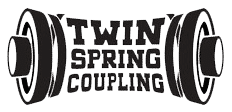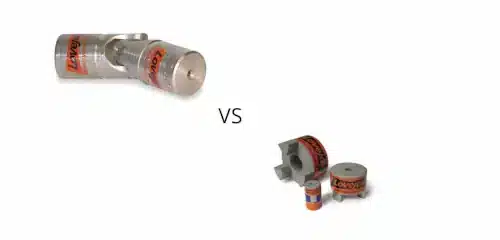Universal Joints vs. Jaw Couplings: Which is Best for Your Industrial Application
Table of Contents
When it comes to keeping industrial machinery running smoothly, power transmission components play a crucial role. Two popular types of couplings often used in industrial applications are universal joints (U-joints) and jaw couplings. Both have their strengths and weaknesses, but the key to selecting the right one lies in understanding their design, function, and where they perform best.
In this post, we’ll explore the ins and outs of universal joints and jaw couplings, helping you make an informed decision on which is best for your industrial application. With over 20 years of experience in the coupling industry, I’ve seen firsthand how the right choice can improve equipment performance, reduce downtime, and save costs in the long run.
What Are Universal Joints?
Overview
Universal joints, commonly referred to as U-joints, are mechanical components that connect rotating shafts in industrial machinery. They are designed to transmit torque and motion between two shafts that are not in line with each other, allowing for angular misalignment.
How They Work: U-joints consist of two yokes (one attached to each shaft) connected by a cross-shaped piece called the “spider.” This spider allows the shafts to rotate at different angles without losing the connection between them. U-joints are often used in applications where the shafts may need to operate at varying angles, such as in conveyors, heavy machinery, and steering columns.
Advantages of Universal Joints
- Handles Angular Misalignment: One of the biggest advantages of U-joints is their ability to handle significant angular misalignment. They are perfect for machinery that operates with varying shaft angles, making them ideal for industrial equipment where flexibility is key.
- High Torque Transmission: U-joints are built to transmit high levels of torque, which is essential for many heavy-duty industrial applications. Their robust design allows them to handle the demands of industrial machinery, from conveyor belts to power drives.
- Durability in Tough Conditions: U-joints are designed to withstand harsh conditions, including extreme temperatures, dirt, and moisture. This makes them a good fit for industries like mining, construction, and manufacturing, where equipment is exposed to the elements.
Disadvantages of Universal Joints
- Limited Speed Capability: While U-joints excel in handling torque, they are not ideal for high-speed applications. The varying angles at which they operate can create vibration, especially at higher speeds, which may lead to wear and tear on other parts of the machine.
- Maintenance Required: U-joints typically require regular lubrication to function properly. Without adequate maintenance, they can experience premature wear, leading to costly repairs or replacements.
- Potential for Misalignment Issues: Although U-joints are designed to accommodate angular misalignment, they can experience problems if the misalignment exceeds their limits. Extreme misalignment can result in vibration, noise, and reduced lifespan.
What Are Jaw Couplings?
Overview
Jaw couplings, on the other hand, are a type of flexible coupling that connects two shafts while allowing for misalignment and absorbing vibrations. Unlike U-joints, jaw couplings rely on an elastomer insert (called a spider) between two hubs to transmit torque and dampen vibrations.
How They Work: The spider fits between the two hubs, and as the hubs rotate, they compress the spider, transmitting torque while absorbing vibration and accommodating small amounts of misalignment. Jaw couplings are widely used in various industrial applications, including pumps, compressors, and conveyors.
Advantages of Jaw Couplings
- Vibration Damping: Jaw couplings are great for applications where vibration damping is needed. The elastomeric spider absorbs shocks, which reduces wear on other machine components, leading to longer equipment life.
- Accommodates Misalignment: While jaw couplings cannot handle as much angular misalignment as U-joints, they can accommodate slight misalignment (angular, axial, and parallel), making them versatile for many industrial applications.
- Maintenance-Free: One of the most attractive features of jaw couplings is their low maintenance requirements. Since the elastomer spider acts as a buffer, there is no need for lubrication, and the coupling can operate for long periods without intervention.
- Cost-Effective: Jaw couplings tend to be more affordable than U-joints, both in terms of initial cost and maintenance. They are an excellent option for applications where cost control is a priority.
Disadvantages of Jaw Couplings
- Limited Misalignment Capability: While jaw couplings can accommodate small misalignments, they are not suitable for applications where significant misalignment is expected. In such cases, U-joints would be a better choice.
- Limited Torque Capacity: Jaw couplings are generally not designed for high-torque applications. If your industrial machinery requires the transmission of heavy loads, a jaw coupling may not be the best option.
- Spider Wear: Over time, the elastomer spider may wear out, particularly in harsh conditions or high-vibration environments. This wear can lead to reduced performance and eventually require replacement of the spider.
Comparing Universal Joints and Jaw Couplings
Now that we have a basic understanding of how universal joints and jaw couplings work, let’s compare the two based on a few critical factors:
1. Misalignment Handling
- Universal Joints: U-joints are superior when it comes to handling large angular misalignments. If your machinery operates at varying angles or if the shafts are not perfectly aligned, U-joints are the better choice.
- Jaw Couplings: Jaw couplings can handle slight angular, parallel, and axial misalignments, but their capacity for angular misalignment is limited. They are more suited for applications with minor misalignment.
2. Torque Transmission
- Universal Joints: U-joints excel in high-torque applications and are commonly used in heavy-duty industrial machinery. They can handle the stresses of high loads without compromising performance.
- Jaw Couplings: Jaw couplings are better for light to moderate torque transmission. If your application involves heavy loads, U-joints will likely be a better fit.
3. Vibration and Shock Absorption
- Universal Joints: U-joints are not known for their vibration-damping capabilities. In fact, at higher speeds, they can produce vibration due to misalignment.
- Jaw Couplings: Jaw couplings are designed to absorb vibration and shocks, making them ideal for applications where smooth operation is critical.
4. Maintenance Requirements
- Universal Joints: U-joints require regular lubrication to ensure smooth operation and prevent wear. This maintenance is necessary to extend the lifespan of the joint.
- Jaw Couplings: Jaw couplings are essentially maintenance-free. The elastomer spider provides vibration damping and can last for a long time without intervention.
5. Cost
- Universal Joints: U-joints tend to be more expensive, both in terms of initial cost and maintenance requirements. However, they provide better performance in heavy-duty and high-torque applications.
- Jaw Couplings: Jaw couplings are generally more affordable and require less maintenance, making them cost-effective for many industrial applications.
When to Choose Universal Joints
You should consider using universal joints in the following situations:
- Your equipment requires significant angular misalignment.
- The application involves high-torque transmission.
- Durability is key, and your equipment operates in harsh environments (e.g., mining, construction).
Common industrial applications where U-joints are ideal include:
- Conveyors with varying shaft angles.
- Heavy-duty equipment like loaders, cranes, and hoists.
- Equipment exposed to dirt, dust, and extreme temperatures.
When to Choose Jaw Couplings
On the other hand, jaw couplings are the better choice when:
- You need to reduce vibration and shocks in your machinery.
- Misalignment is minimal but still needs to be accommodated.
- The application involves light to moderate torque transmission.
- You want a low-maintenance and cost-effective solution.
Jaw couplings are frequently used in:
- Pumps and compressors.
- Light industrial machinery.
- Applications where smooth, quiet operation is essential.
Final Thoughts: Which is Best for You?
At the end of the day, the choice between universal joints and jaw couplings depends on your specific industrial application. If your equipment operates with varying shaft angles and needs to handle heavy loads, universal joints are likely the best option.
However, if your machinery needs to reduce vibration and handle light to moderate loads with minimal maintenance, jaw couplings are a better fit.
Whichever option you choose, it’s essential to consider factors like misalignment, torque, and vibration when making your decision. By selecting the right coupling, you can improve the efficiency of your equipment, reduce downtime, and save on repair costs in the long run.
Universal Joints vs. Jaw Couplings: Which is Best for Your Industrial Application
Need help finding the perfect coupling for your industrial machinery? At Twin Spring Coupling, we offer a wide range of universal joints and jaw couplings from trusted brands like Lovejoy, SKF, Rexnord, TB Woods, Boston Gear, and Kopflex.
With over 20 years of experience in the coupling industry, we can help you make the best choice for your application.

